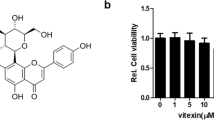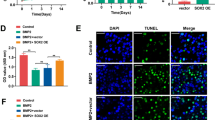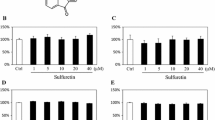Abstract
Apigenin is a plant-derived flavonoid and has been reported to prevent bone loss in ovariectomized mice, but the role of apigenin on osteogenic differentiation of human mesenchymal stem cells (hMSCs) has not been reported. In the present study, the effect of apigenin on osteogenic differentiation of hMSCs was explored. Our results showed that apigenin treatment significantly increased alkaline phosphatase (ALP) activity and mineralization in hMSCs. RT-PCR revealed that apigenin markedly up-regulated the mRNA expression of osteopontin (OPN) and the transcription factors runt-related transcription factor 2 (Runx2). The expression of Runx2 and osterix (OSX) proteins were also increased in hMSCs differentiating into osteoblasts after treatment with apigenin. Furthermore, we investigated the signaling pathways responsible for osteogenic differentiation of apigenin in hMSCs. We found that apigenin treatment significantly increased the levels of p-JNK, p-p38 in hMSCs and addition of the inhibitors of JNK (SP600125) or p38 MAPK (SB203580) eliminated the stimulating effects of apigenin. In addition, addition of SP600125 or SB203580 also blocked apigenin-induced ALP activity, OPN, Runx2, and OSX expression and meanwhile inhibited bone nodule formation. Taken together, these findings suggest apigenin promotes the osteogenesis of hMSCs through activation of JNK and p38 MAPK signal pathways which leads to Runx2 and OSX expressions to induce the formation of bone nodule.








Similar content being viewed by others
References
Ke HZ, Richards WG, Li X, Ominsky MS (2012) Sclerostin and dickkopf-1 as therapeutic targets in bone diseases. Endocr Rev 33:747–783
Rachner TD, Khosla S, Hofbauer LC (2011) Osteoporosis: now and the future. Lancet 377:1276–1287
Marie PJ, Kassem M (2011) Osteoblasts in osteoporosis: past, emerging, and future anabolic targets. Eur J Endocrinol 165:1–10
Sandhu SK, Hampson G (2011) The pathogenesis, diagnosis, investigation and management of osteoporosis. J Clin Pathol 64:1042–1050
Pittenger MF, Mackay AM, Beck SC, Jaiswal RK, Douglas R, Mosca JD, Moorman MA, Simonetti DW, Craig S, Marshak DR (1999) Multilineage potential of adult human mesenchymal stem cells. Science 284:143–147
Jiang Y, Jahagirdar BN, Reinhardt RL, Schwartz RE, Keene CD, Ortiz-Gonzalez XR, Reyes M, Lenvik T, Lund T, Blackstad M, Du J, Aldrich S, Lisberg A, Low WC, Largaespada DA, Verfaillie CM (2002) Pluripotency of mesenchymal stem cells derived from adult marrow. Nature 418:41–49
Wang X, Wang Y, Gou W, Lu Q, Peng J, Lu S (2013) Role of mesenchymal stem cells in bone regeneration and fracture repair: a review. Int Orthop 37:2491–2498
Cao L, Liu G, Gan Y, Fan Q, Yang F, Zhang X, Tang T, Dai K (2012) The use of autologous enriched bone marrow MSCs to enhance osteoporotic bone defect repair in long-term estrogen deficient goats. Biomaterials 33:5076–5084
Shekkeris AS, Jaiswal PK, Khan WS (2012) Clinical applications of mesenchymal stem cells in the treatment of fracture non-union and bone defects. Curr Stem Cell Res Ther 7:127–133
Guan M, Yao W, Liu R, Lam KS, Nolta J, Jia J, Panganiban B, Meng L, Zhou P, Shahnazari M, Ritchie RO, Lane NE (2012) Directing mesenchymal stem cells to bone to augment bone formation and increase bone mass. Nat Med 18:456–462
Dalle Carbonare L, Valenti MT, Zanatta M, Donatelli L, Lo Cascio V (2009) Circulating mesenchymal stem cells with abnormal osteogenic differentiation in patients with osteoporosis. Arthritis Rheumatol 60:3356–3365
Benisch P, Schilling T, Klein-Hitpass L, Frey SP, Seefried L, Raaijmakers N, Krug M, Regensburger M, Zeck S, Schinke T, Amling M, Ebert R, Jakob F (2012) The transcriptional profile of mesenchymal stem cell populations in primary osteoporosis is distinct and shows overexpression of osteogenic inhibitors. PLoS One 7:e45142
Pino AM, Rosen CJ, Rodriguez JP (2012) In osteoporosis, differentiation of mesenchymal stem cells (MSCs) improves bone marrow adipogenesis. Biol Res 45:279–287
Jarry H, Spengler B, Porzel A, Schmidt J, Wuttke W, Christoffel V (2013) Evidence for estrogen receptor beta-selective activity of vitex agnus-castus and isolated flavones. Planta Med 69:945–947
Shukla S, Gupta S (2004) Molecular mechanisms for apigenin-induced cell-cycle arrest and apoptosis of hormone refractory human prostate carcinoma DU145 cells. Mol Carcinogen 39:114–126
Fang J, Zhou Q, Liu LZ, Xia C, Hu X, Shi X, Jiang BH (2007) Apigenin inhibits tumor angiogenesis through decreasing HIF-1alpha and VEGF expression. Carcinogenesis 28:858–864
Hiremath SP, Badami S, Hunasagatta SK, Patil SB (2000) Antifertility and hormonal properties of flavones of Striga orobanchioides. Eur J Pharmacol 391:193–197
Shukla S, Gupta S (2007) Apigenin-induced cell cycle arrest is mediated by modulation of MAPK, PI3K-Akt, and loss of cyclin D1 associated retinoblastoma dephosphorylation in human prostate cancer cells. Cell Cycle 6:1102–1114
Rithidech KN, Tungjai M, Reungpatthanaphong P, Honikel L, Simon SR (2012) Attenuation of oxidative damage and inflammatory responses by apigenin given to mice after irradiation. Mutat Res 749:29–38
Bandyopadhyay S, Lion JM, Mentaverri R, Ricupero DA, Kamel S, Romero JR, Chattopadhyay N (2006) Attenuation of osteoclastogenesis and osteoclast function by apigenin. Biochem Pharmacol 72:184–197
Hougee S, Sanders A, Faber J, Graus YM, van den Berg WB, Garssen J, Smit HF, Hoijer MA (2005) Decreased pro-inflammatory cytokine production by LPS-stimulated PBMC upon in vitro incubation with the flavonoids apigenin, luteolin or chrysin, due to selective elimination of monocytes/macrophages. Biochem Pharmacol 69:241–248
Choi EM (2007) Apigenin increases osteoblastic differentiation and inhibits tumor necrosis factor-alpha-induced production of interleukin-6 and nitric oxide in osteoblastic MC3T3-E1 cells. Pharmazie 62:216–220
Jung WW (2014) Protective effect of apigenin against oxidative stress-induced damage in osteoblastic cells. Int J Mol Med 33:1327–1334
Park JA, Ha SK, Kang TH, Oh MS, Cho MH, Lee SY, Lee SY, Park JH, Kim SY (2008) Protective effect of apigenin on ovariectomy-induced bone loss in rats. Life Sci 82:1217–1223
Goto T, Hagiwara K, Shirai N, Yoshida K, Hagiwara H (2015) Apigenin inhibits osteoblastogenesis and osteoclastogenesis and prevents bone loss in ovariectomized mice. Cytotechnology 67:357–365
Liao Y, Shen W, Kong G, Lv H, Tao W, Bo P (2014) Apigenin induces the apoptosis and regulates MAPK signaling pathways in mouse macrophage ANA-1 cells. PLoS One 9:e92007
Ye Y, Wang H, Chu JH, Chou GX, Yu ZL (2011) Activation of p38 MAPK pathway contributes to the melanogenic property of apigenin in B16 cells. Exp Dermatol 20:755–757
Wang X, Goh CH, Li B (2007) p38 mitogen-activated protein kinase regulates osteoblast differentiation through osterix. Endocrinology 148:1629–1637
Greenblatt MB, Shim JH, Zou W, Sitara D, Schweitzer M, Hu D, Lotinun S, Sano Y, Baron R, Park JM, Arthur S, Xie M, Schneider MD, Zhai B, Gygi S, Davis R, Glimcher LH (2010) The p38 MAPK pathway is essential for skeletogenesis and bone homeostasis in mice. J Clin Invest 120:2457–2473
Kwon HS, Johnson TV, Tomarev SI (2013) Myocilin stimulates osteogenic differentiation of mesenchymal stem cells through mitogen-activated protein kinase signaling. J Biol Chem 288(23):16882–16894
Xu D, Xu L, Zhou C, Lee WY, Wu T, Cui L, Li G (2014) Salvianolic acid B promotes osteogenesis of human mesenchymal stem cells through activating ERK signaling pathway. Int J Biochem Cell Biol 51:1–9
Patel D, Shukla S, Gupta S (2007) Apigenin and cancer chemoprevention: progress, potential and promise (review). Int J Oncol 30:233–245
Orimo H, Shimada T (2008) The role of tissue-nonspecific alkaline phosphatase in the phosphate-induced activation of alkaline phosphatase and mineralization in SaOS-2 human osteoblast-like cells. Mol Cell Biochem 315:51–60
Gordon JA, Tye CE, Sampaio AV, Underhill TM, Hunter GK, Goldberg HA (2007) Bone sialoprotein expression enhances osteoblast differentiation and matrix mineralization in vitro. Bone 41:462–473
Ducy P, Zhang R, Geoffroy V, Ridall AL, Karsenty G (1997) Osf2/Cbfa1: a transcriptional activator of osteoblast differentiation. Cell 89:747–754
Nakashima K, Zhou X, Kunkel G, Zhang Z, Deng JM, Behringer RR, de Crombrugghe B (2002) The novel zinc finger-containing transcription factor osterix is required for osteoblast differentiation and bone formation. Cell 108:17–29
Gordeladze JO, Noel D, Bony C, Apparailly F, Louis-Plence P, Jorgensen C (2008) Transient down-regulation of cbfa1/Runx2 by RNA interference in murine C3H10T1/2 mesenchymal stromal cells delays in vitro and in vivo osteogenesis, but does not overtly affect chondrogenesis. Exp Cell Res 314:1495–1506
Tu Q, Valverde P, Chen J (2006) Osterix enhances proliferation and osteogenic potential of bone marrow stromal cells. Biochem Biophys Res Commun 341:1257–1265
Yao KL, Todescan R Jr, Sodek J (1994) Temporal changes in matrix protein synthesis and mRNA expression during mineralized tissue formation by adult rat bone marrow cells in culture. J Bone Miner Res 9:231–234
Liao QC, Xiao ZS, Qin YF, Zhou HH (2007) Genistein stimulates osteoblastic differentiation via p38 MAPK–Cbfa1 pathway in bone marrow culture. Acta Pharmacol Sin 28:1597–1602
Guicheux J, Lemonnier J, Ghayor C, Suzuki A, Palmer G, Caverzasio J (2003) Activation of p38 mitogen-activated protein kinase and c-Jun-NH2-terminal kinase by BMP-2 and their implication in the stimulation of osteoblastic cell differentiation. J Bone Miner Res 18:2060–2068
Cuenda A, Rousseau S (2007) p38 MAP-kinases pathway regulation, function and role in human diseases. Biochim Biophys Acta 1773:1358–1375
Acknowledgments
We thank financial support from National Natural Science Foundation of China (30772768, 81102450), Science and Technology Planning Project of Guangdong Province (2013B031800013); Natural Science Foundation of Guangdong Province (2014A030313534); Science and Technology Planning Project for Medical Treatment and Public Health of Dongguan (2014105101294); and Initiating Fund of Scientific Research for Doctors of Guangdong Medical University (B2013016).
Conflict of interest
The authors declare no conflict of interest.
Author information
Authors and Affiliations
Corresponding authors
Additional information
Xue Zhang, Chenhui Zhou and Xuan Zha have contributed equally to this work.
Rights and permissions
About this article
Cite this article
Zhang, X., Zhou, C., Zha, X. et al. Apigenin promotes osteogenic differentiation of human mesenchymal stem cells through JNK and p38 MAPK pathways. Mol Cell Biochem 407, 41–50 (2015). https://doi.org/10.1007/s11010-015-2452-9
Received:
Accepted:
Published:
Issue Date:
DOI: https://doi.org/10.1007/s11010-015-2452-9




